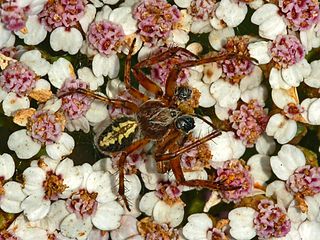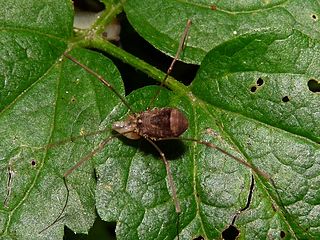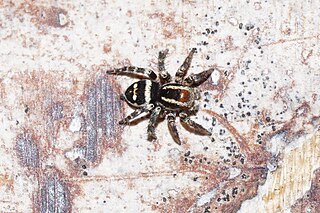
The giant house spider has been treated as either one species, under the name Eratigena atrica, or as three species, E. atrica, E. duellica and E. saeva. As of April 2020, the three species view was accepted by the World Spider Catalog. They are among the largest spiders of Central and Northern Europe. They were previously placed in the genus Tegenaria. In 2013, they were moved to the new genus Eratigena as the single species Eratigena atrica. In 2018, the three separate species were restored. The bite of these species does not pose a threat to humans or pets, and they are generally reluctant to bite, preferring instead to hide or escape.

Aculepeira ceropegia, the oak spider, is an orb-weaving spider species belonging to the family Araneidae.

Araniella cucurbitina, sometimes called the "cucumber green spider", is a spider of the family Araneidae. Araniella Cucurbitina is found across Europe, Western Asia, Central Asia and Japan. The “cucurbitina” in Araniella Cucurbitina comes from the word “cucurbit” which is a family of plants including cucumbers.

Tegenaria parietina is a rather rare spider in Europe, with a distribution also including Northern Africa to Central Asia and Sri Lanka, and from the West Indies to Uruguay and Argentina, where it may have been introduced. In the UK it is sometimes known as the cardinal spider because of the legend that Cardinal Wolsey was terrified by this species at Hampton Court, or, conversely, because he regarded them as lucky and forbade anyone to harm them. In 2013, Tegenaria taprobanica was included in this species.

Alopecosa accentuata is a species of wolf spider found commonly in open habitats throughout continental Europe with a reported palearctic distribution. The female has a body length of up to 12 mm, the male is rather smaller at up to 9 mm. The name was at one time treated as a nomen dubium, but is now considered the correct name of Alopecosa barbipes.

Titanoeca quadriguttata is a species of spider in the family Titanoecidae. It is widespread in Europe, though absent from Great Britain, and is found in Austria, Belgium, Bulgaria, Corsica, Croatia, Czech Republic, France, Germany, Greece, Hungary, Italy, Liechtenstein, Moldova, Russia, Slovakia, Spain, Switzerland, the Netherlands, Ukraine.

Synema globosum is a species of spiders belonging to the family Thomisidae. It is sometimes called the Napoleon spider, because of a supposed resemblance of the markings on the abdomen to a silhouette of Napoleon wearing his iconic hat.
Attulus caricis is a species of spider in the family Salticidae. It has a Palearctic distribution, including Britain. Until 2017, it was placed in the genus Sitticus.

Attulus saltator is a species of jumping spider, from the Sitticinae subfamily. It was first described by Frederick Octavius Pickard-Cambridge in 1868 and has a Palearctic distribution, including Great Britain.

Attulus inexpectus is a species of spider from family Salticidae, found in from Europe to central Asia. It was previously misidentified as Attulus rupicola.

Neriene montana is a species of spider belonging to the family Linyphiidae. With a holarctic distribution, it is found throughout northern Europe.

Leiobunum blackwalli is a species of harvestman. It is found in Europe.

Dictyna arundinacea is a species of spider belonging to the family Dictynidae. It has a holarctic distribution; It is found throughout Britain and northern Europe.

Hyptiotes paradoxus, also known as the triangle spider, is a cribellate orbweaver in the family Uloboridae.

Lepthyphantes minutus is a species of spider belonging to the family Linyphiidae. Despite its name it is one of the larger species of Lepthyphantes. It is found throughout Northern Europe.

Drassodes cupreus is a species of spider in the genus Drassodes, family Gnaphosidae. A ground-living nocturnal hunter, it spends the day in a silken retreat.

Theridiosoma gemmosum is a species of spider in the family Theridiosomatidae, known as ray spiders. It is widely distributed in the Holarctic region. A small spider with a shiny globular abdomen, it constructs a conical orb web.

Heliophanus cupreus, the copper sun jumper, is a species of jumping spider belonging to the family Salticidae.

Stenaelurillus zambiensis is a species of jumping spider in the genus Stenaelurillus that lives in Malawi, Zambia and Zimbabwe. It was first described in 2014 by Wanda Wesołowska. The spider is small, the male being smaller than the female, with a brown carapace between 2.6 and 3.2 mm in length and black-brown abdomen between 2.6 and 3.0 mm in length. The male has a distinctive metallic sheen on its abdomen and eye field. The male carapace is marked with two white streaks while the female has white stripes. It is distinguished from other members of the genus by the male's hook-shaped end to the embolus and the two depressions in the female epigyne.

Ebrechtella tricuspidata is a species of crab spiders belonging to the family Thomisidae.



















